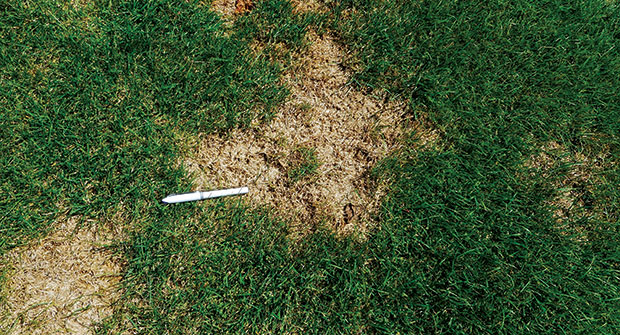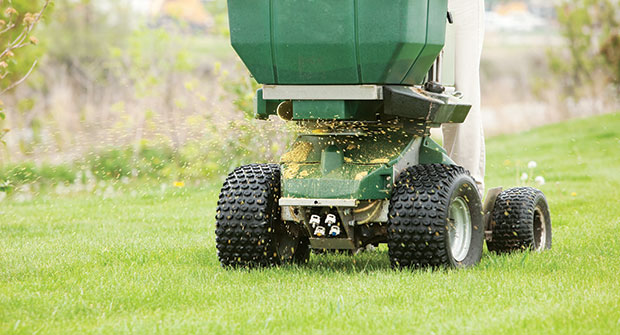
Summer patch is another headache for lawn care professionals. Here are some tips for identification and control of this pesky pathogen from Brian A. Aynardi, Ph.D., Northeast research scientist with PBI-Gordon; Lane Tredway, Ph.D., technical services manager for Syngenta; and Jamie Heydinger, cool-season national account manager with Nufarm.
What to look for
Symptoms include a “frog-eye” pattern with gradual enlarging patches with no foliar signs of pathogen. Summer patch appears with warm summer temperatures, especially after rainy periods. It is associated with saturated soils that have poor drainage. Summer patch can occur when soil temperatures reach above 70 degrees F for at least 48 hours. The pathogen favors high daytime temperature (85 degrees F) and warm nights (70 degrees F). — Jamie Heydinger
Patches or rings from 6 inches to 3 feet in diameter appear during summer stress. Infected turf initially wilts or turns yellow; then comes tan- to orange-colored dieback. The crown, roots and rhizomes of affected plants will be dark and rotten. — Lane Tredway
How to control it
The summer patch pathogen begins infecting roots in the spring when soil temperatures reach 65 degrees F. This is the best time to initiate a preventive fungicide program. Azoxystrobin, propiconazole or penthiopyrad fungicides are highly effective options for summer patch prevention. Granular or spray applications should be watered into the soil for best results. — Lane Tredway
Fungicide groups with active ingredients offering the best control are the strobilurin and DMIs, with combination products or tank mixes of those two groups performing exceptionally well. Preventive applications should be watered-in immediately with at least 1/8-inch of irrigation. A minimum of two to three preventive applications 21-28 days apart is optimal. — Brian Aynardi
Use acidifying (AMS) and slow-release fertilizers. — Jamie Heydinger
Keep in mind
It is problematic in Kentucky bluegrass, annual bluegrass and fine fescue lawns. — Brian Aynardi
Avoid low mowing heights. Alleviate stress by avoiding overirrigation; mow high. Aerification may relieve compaction. Plant-to-plant movement of disease happens via roots and rhizomes. It can be spread by aeration and dethatching. It can come from infected sod. — Jamie Heydinger
Summer patch is most severe in compacted areas or where soil pH is high. Aerify regularly to alleviate soil compaction, and apply lime only as needed based on soil test results. Mixtures with resistant species, such as tall fescue or perennial ryegrass, can help mask summer patch symptoms. It will generally leave tall fescue or perennial ryegrass unaffected. — Lane Tredway


